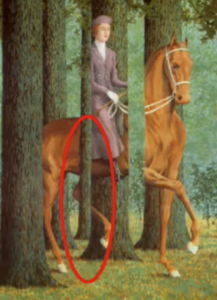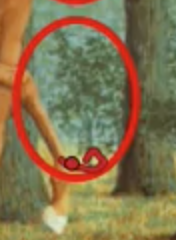Working Essay
Will it not turn out, with further scientific developments, that the study of the universe and the study of consciousness will be inseparably linked, and that, ultimately, progress in the one will be impossible without progress in the other? After the development of a unified geometrical description of the weak, strong, electromagnetic, and gravitational interactions, will the next important step not be the development of a unified approach to our entire world, including the world of consciousness? – Andrei Linde Professor Theoretical Physics Stanford
Contents
Illusions of the Mind
VISUAL
Take the example of the following painting by Rene Magritte.
“The Blank Check” – Rene Magritte
The artist makes clever use of several perceptual cues including occlusion, blurrying, and sizing.
Occlusion: The tree seems to occlude the horse’s torso giving the perception that the tree is closer to us.
Blurring/Hazing: The size and blurriness of the tree, give the impression that the tree is far away.
TIME
Past. Present. Future.
Exercise:
Inquiry about past, present future.
SPACE
Bodily awareness. Space and boundaries. Henrik Ehrsson’s research1)http://130.237.111.254/ehrsson/pdfs/Abdulkarim&Ehrsson2015inpress.pdf on bodily awareness shows that the felt sense of physical self is fluid. 2)http://www.nature.com/polopoly_fs/1.9569!/menu/main/topColumns/topLeftColumn/pdf/480168a.pdf
Neuroscience Term Review
 3)http://www.ncbi.nlm.nih.gov/pubmed/22049421
3)http://www.ncbi.nlm.nih.gov/pubmed/22049421
Anterior Cingulate Cortex (ACC) –
PCC
Default Mode Network
Precuneus
Medial Prefrontal Cortex
Parietals
Thalamus
Common Electroencephalograph (EEG) Banded Frequencies
It’s important to note that descriptions about EEG related behavior are helpful yet often quit misleading. It’s common for beginning neuroscientists to be bombarded with generalizations such as alpha for meditation, beta for alertness, theta for fog, and sensorimotor rhythm(SMR) for calm. It suggest that each EEG bandwith is one dimensional or independent. In reality, these frequency bands make up definitive parts of the whole raw EEG.
BETA(13-21 Hz)
Beta is comprised of fast wave activity, or any rhythmic activity more than 13Hz4)Blume & Kaibara, 1995, p.39 . It has been associated with focus, analytical thinking, externally oriented, or in a state of relaxed thinking. Others define beta as 13-21, 15-20, or 13-32Hz.
ALPHA(9-12 Hz)
Alpha
Evolution of the Ego
(d3 visualization of ego development)
[d3-source canvas=”wpd3-765-0″]
Introduction
Natural selection has selected for genes which promote reproduction. The system is not always geared towards seeing the world clearly. Evolutionary biology is has an inherent bias towards fear.
Self Referential Networks
Functional linkages between the medial regions of the precuneus and the anterior cingulate cortex and the angular gyri on the parietal convexity have been implicated in “reflective self awareness”. 5)
Austin, J. 2010. “Asian perspectives: Indian theories of mind.” In The Cambridge Handbook of Consciousness. P.D. Zelazo, M. Moscovitch & E. Thompson, Eds.: 204. Cambridge: Cambridge University Press. –fix this.
Present Centered Awareness
So close you can’t see it.
So deep you can’t fathom it.
So simple you can’t believe it.
So good you can’t accept it.
Selfing
Developmental stages. Symbolic language.
Reification
Non-essentialism..
The Importance of First Person Verification
Francisco Varela Resources for First Person Methods 6)http://web.archive.org/web/20050107033506/http://www.ccr.jussieu.fr/varela/human_consciousness/article01.html
Open Questions in Contemplative/Cognitive Neuroscience
- Neural correlates of awakening
- Physiology of Central Channel Practices
- Emotional Coupling – Thought + Bodily Sensation.
- N.C. of duality vs non-duality
- N.C. of fixation in attention
- Applying Cognitive Behavioral Therapy to Embodied Awareness
- Cognitive re-framing nondual awareness
References
References
| 1. | ↑ | http://130.237.111.254/ehrsson/pdfs/Abdulkarim&Ehrsson2015inpress.pdf |
| 2. | ↑ | http://www.nature.com/polopoly_fs/1.9569!/menu/main/topColumns/topLeftColumn/pdf/480168a.pdf |
| 3. | ↑ | http://www.ncbi.nlm.nih.gov/pubmed/22049421 |
| 4. | ↑ | Blume & Kaibara, 1995, p.39 |
| 5. | ↑ |
Austin, J. 2010. “Asian perspectives: Indian theories of mind.” In The Cambridge Handbook of Consciousness. P.D. Zelazo, M. Moscovitch & E. Thompson, Eds.: 204. Cambridge: Cambridge University Press. –fix this. |
| 6. | ↑ | http://web.archive.org/web/20050107033506/http://www.ccr.jussieu.fr/varela/human_consciousness/article01.html |








